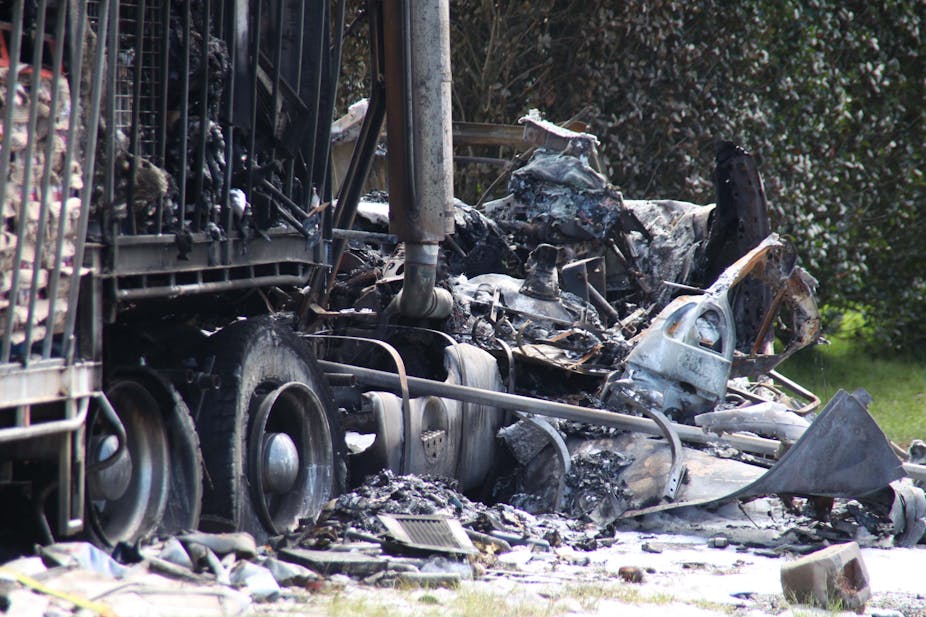Articulated trucks such as semi-trailers and “B-Doubles” are involved in about 30% of fatal road accidents on the Pacific Highway. As the number of trucks carrying freight between Sydney and Brisbane increases, we will see more tragic incidents like the fatal crash involving a B-Double on 8 January 2012 near Urunga.
In August 2002, following completion of a new section of dual carriageway between Yelgun and Chinderah, the NSW Roads and Traffic Authority gave approval for large B-Doubles to use the entire length of the Pacific Highway. This decision led to a 38% increase in the number of heavy trucks using the Pacific Highway each day. By 2006, when 168 kilometres of dual carriageway had been built, 75% of Sydney-Brisbane intercity freight was travelling by road, leaving rail with 25%.
With further Pacific Highway upgrading between Hexham and the NSW-Queensland border, 338 kilometres (about half) of this highway is now dual carriageway. Truck numbers have continued to increase. Since 2002, Sydney-Brisbane road freight has increased from about 1.5 to over 6 million tonnes per annum. Rail’s share of this intercity freight has fallen to less than 10%.
Making the entire highway dual carriageway would improve safety and reduce congestion, but this work is unlikely to be completed by 2016. Given the Kempsey Bypass is averaging over $40 million per kilometre, completing the highway is likely to cost $14 billion rather than quoted estimates of $8 billion.
The issue of heavy trucks on the Pacific Highway, and the stern safety challenges, were addressed by a committee of the NSW Legislative Council in 2006. “There was widespread community support for greater use of rail freight to reduce the environmental and safety impact of heavy vehicles,” the report noted.

As demonstrated between Melbourne, Adelaide and Perth, moving more heavy goods between capital cities can be accomplished with a good rail system. However, this is near impossible with the antiquated NSW system. The constraints include rail congestion around Sydney and rail alignments on the route to Brisbane that were designed for steam-age trains.
For example, the tracks between Maitland and Grafton started as branch lines, built on the cheap in the early 20th century before later being joined. As a result, a train moving between Maitland and Grafton traverses 55 circles to the left and 55 circles to the right over track with excessive curvature and extra length.¹
Basic track and signal upgrades between Sydney and Brisbane have been completed by the Australian Rail Track Corporation (ARTC). As a result, average freight train speeds between Sydney and Brisbane will be lifted from an inadequate 50 km/h to about 65 km/h. To make rail a viable alternative for freight an average speed of 80km/h is needed. This will mean rebuilding some sections of track, such as Hexham to Stroud Road, to modern engineering standards.
Quite simply, this track (and the Sydney-Melbourne track) is “…inadequate for current and future needs."²
The chairman of the House of Representatives Inquiry into "The Great Freight Task: Is Australia’s transport network up to the challenge”, Paul Neville MP, expressed the big picture well on ABC radio: “We know that the freight task is going to double in the next 20 years, and, because of that, our roads will become totally and utterly congested if we don’t do something serious about rail in that time.
"If we’re not progressing rail in parallel with road, in other words, if rail doesn’t really catch up, all we’re doing is exacerbating the amount of freight that will go on the newly upgraded roads, and that would be ones like the Hume Highway and the Pacific Highway.”
To date the Federal and NSW Governments have given priority to rebuilding the Pacific Highway. What is really needed is a better rail system so rail is able to “really catch up” and freight can be moved off the road altogether.
The Federal Government must adopt a balanced approach to rebuilding sections of the North Coast railway as well as the Pacific Highway. Such a balance between road and rail would improve road safety and reduce the impact on the environment.
The average accident risk for road freight is about 20 times that of rail freight. Rail freight uses about one-third of the diesel that trucks use, so there are potential significant greenhouse gas reductions (more than 150,000 tonnes a year) from a “fit for purpose” North Coast line.
These are compelling reasons for a balanced approach by both the Federal Government and the NSW Government.
References
Philip Laird, Sydney-Brisbane Land Transport, 2007 Australasian Transport Research Forum, at patrec.org
Len Harper, Chartered Institute of Logistics and Transport The major task of increasing rail traffic on the East Coast
Track and Signal Oct-Nov-Dec 2008 (p9-13).

